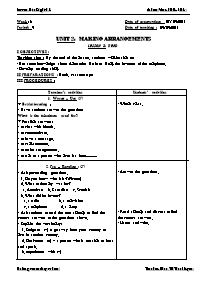Giáo án môn Tiếng Anh Lớp 8 - Unit 2: Making arrangements - Lesson 3: Read

1. Warm – Up: (5’)
* Brainstorming:
- Have students answer the question:
What is the telephone used for?
* Possible answers:
- to chat with friends.
- to communicate.
- to have a message.
- to call someone.
- to make arrangements.
- to talk to a person who lives far from
Bạn đang xem tài liệu "Giáo án môn Tiếng Anh Lớp 8 - Unit 2: Making arrangements - Lesson 3: Read", để tải tài liệu gốc về máy bạn click vào nút DOWNLOAD ở trên
Week: 3 Date of preparation: 07/ 09/2011 Period: 9 Date of teaching: 09/ 09/2011 UNIT 2: MAKING ARRANGEMENTS LESSON 3: READ I. OBJECTIVES: Teaching aims: By the end of the lesson, students will be able to: - Get some knowledge about Alexander Graham Bell, the inventor of the telephone. - Develop reading skill. II. PREPARATIONS: Book, cassette tape III. PROCEDURES: Teacher’s activities Students’ activities 1. Warm – Up: (5’) * Brainstorming: - Have students answer the question: What is the telephone used for? * Possible answers: - to chat with friends. - to communicate. - to have a message. - to call someone. - to make arrangements. - to talk to a person who lives far from 2. Pre – Reading: (5’) - Ask pre-reading questions. 1. Do you know who it is? (Picture) 2. What nationality was he? a. American b. Canadian c. Scottish 3. What did he invent? a. a radio b. a television c. a telephone d. a lamp - Ask students to read the text silently to find the correct answers to the questions above. - Explain the vocabulary: 1. Emigrate (v) = go away from your country to live in another country. 2. Deaf-mute (n) – a person who is not able to hear and speak. 3. experiment with (v) 4. transmit (v) 5. Assistant (n) = someone who helps. 6. conduct (v) 7. device (n) 8. demonstrate (v) 9. Countless (a) = too many to be counted. 10. exhibition (n) 11. commercial (a) ª be in commercial use - Have students notice the past tense used in the text. 3. While – Reading: (20’) - Have students read the text silently again to do the true/false sentences. - Call students to give the answers. a. F b. F c. T d. F e. F f. T - Have students read the text again to order the events. - Call some students to read the answers. 1. d 2. e 3. a 4. g 5. c 6. b 7. f 4. Post – Reading: (13’) Ask students to read the text again to answer the questions. 1. When and where was Alexander Graham Bell born? 2. What countries did he emigrate? 3. Who did he work with in America? 4. What did he do soon? 5. Did this help him to invent a television? 6. Who helped him to invent this device? 7. What was the first telephone message? 8. When was the first telephone in commercial use 5. Homework: (2’) - Reread the text and redo the exercises. - Prepare next lesson: Unit 2- Write/ p.23, 24. - Whole class. - Answer the questions. - Read silently and discuss to find the correct answers. - Listen and write. - Listen. - Read silently and work in groups. - Give the answers. - Pair works. - Read the answers. - Group works 1. He was born on March 3, 1874 in Edinburgh. 2. He emigrated to Canada and the USA. 3. In America, he worked with deaf-mute at Boston University. 4. He did experiments with ways of transmitting speech over a long distance. 5. No. This helped him to invent a telephone. 6. Thomas Watson. 7. It was “Mr. Watson, come here. I want you.” 8. It was in commercial use by 1877. IV. COMMENTS: -------------------------------------------------------------------------------------------------------------------------------------------------------------------------------------------------------------------------------------- _________________________________________b"&"a__________________________
Tài liệu đính kèm:
 giao_an_mon_tieng_anh_lop_8_unit_2_making_arrangements_lesso.doc
giao_an_mon_tieng_anh_lop_8_unit_2_making_arrangements_lesso.doc






